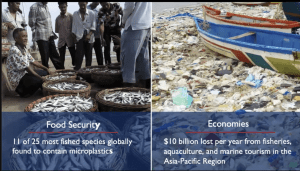Our planet’s capacity to sustain human life is in dire danger. That’s a fact, and so is this: every Rotarian has the power to increase humanity’s ability to survive. Actions you take – from your kitchen to international summits – can help humankind return to sustainable living.The goal is to learn to live within our planetary means.
We start this month’s Sustainable Living stories by linking you to talks by business sustainability consultant and ESRAG Director Gunilla Östberg on the Planetary Boundaries analyses of the Stockholm Resilience Centre. Drawing on research led by Johan Rockström and Will Steffen, she shows the unprecedented strain that human activity is putting on Earth’s capacity to provide the air, water, food, and temperatures we need to live. “We have to decide what kind of future we want,” she says, “and act accordingly in all our roles: in our professions, in elections, as members of organizations like Rotary, as consumers, and as parents. We can still choose life.”

Swedish sustainability consultant and ESRAG Director Gunilla Östberg
ESRAG’s articles this month show Rotarians doing exactly that: combining who they are, where they serve, and who they know to help their communities live sustainably. Climate scientist Katherine Hayhoe urges us to empower people by showing them specific ways they can act to make the world safer for those they love.
Hayhoe points out that people’s values are a core part of who they are, and recommends that we start by listening, to learn about the moral perspectives of the people with whom we’re sharing our environmental concerns. At the start of her book Saving Us (p. 14) she describes how reading the Four Way Test on a West Texas Rotary Club’s banner lifted her heart as she prepared to speak to them about climate change.
The Rotarians featured in this month’s stories are putting Rotary values into action. Solar engineer Jaideep Malaviya is urging Indian clubs to close funding gaps so farmers can afford to replace their diesel-powered water pumps with solar pumps, reducing their operating costs, carbon emissions, and air pollution. Canadian Joey O’Brien, an ESRAG Director, shares insights on how to run a huge zero-waste event. He imagined, and then achieved this for the Banff Marathon by combining his experience in resort and sports management with concern for his grandchildren’s future.
American PDG Jeff Smith, an engineer and retired power company executive, has galvanized Rotarians across several districts to help business, government, and universities develop the skilled workforce for a new green economy. Also in the US, I report on working with my regional faith community to provide grants and technical assistance which have motivated almost 30 churches to make retrofits to reduce their energy consumption and carbon emissions.
Our series this month also connects you to analytical tools you can use to choose high-impact projects that fit the culture, economy, and technology of your community:
- Drawdown Solutions
- En-ROADS Climate Action Simulator
- Global Footprint datasets for national and regional planning
- How carbon markets work
But first, let’s look at the Planetary Boundaries and match them to projects you can explore by using ESRAG’s Task Forces and online resources.
ESRAG Directors Gunilla Ostberg and Dr. Ludwig Kalthoff were invited to speak at the 2022 Rotary International Presidential Conference in Venice on how economies can rebuild better after the pandemic by tackling the “spiralling environmental crisis that needs to be addressed to ensure the survival of our communities” (a quote from the Conference theme). Conference speakers included 2021-22 RI President Shekhar Mehta, European Parliament President Dr. Roberta Metsola, business leaders, RI Directors and key Rotary and United Nations staff.
An engineer with 30 years’ experience helping communities create growth and profitability based on sustainability, Gunilla gave a 17-minute talk on why Rotarians are concerned about the environmental crisis threatening all our other humanitarian goals. She listed nine planetary capacities, at least six of which we’ve already exceeded. Her 30-minute presentation for ESRAG’s Projects + Webinar offers more detail. Both are compelling calls to action you can share with your club or community.
Here’s an overview of five of the six systems that are already in the critical danger zone.

Planetary Boundaries. Credit: Azote for Stockholm Resilience Centre, based on analysis in Wang-Erlandsson et al 2022.
“Climate Change” captures the consequences of greenhouse gases including CO2, methane, and refrigerants: increasingly destructive storms, floods, wildfires, droughts, and the expanding range of disease vectors. Last year’s flooding in Pakistan, with catastrophic losses in crops, farmland, housing, and the resulting rise in poverty and disease, is a giant warning to us all.
“Novel entities” are manmade materials, including plastics and chemicals like PFAS, which are polluting oceans, rivers, lands, air, and the tissues of living creatures including human beings. “Biosphere integrity” describes the accelerating biodiversity loss that imperils the ecological services we depend on. Pollinators, for example, are vital to the human food supply.

One of the slides shared by Rotarian Colin Holmes, USAID Team Lead for Land and Resources Governance, in his December 2020 webinar for ESRAG on the development challenges of ocean plastics.
“Land-system change” includes the crisis of deforestation and habitat loss, exacerbating global warming by reducing natural carbon sinks. These changes endanger other ecological services such as preventing flood damage and retaining topsoil. “Biogeochemical flows” describes the cycles of nitrogen and phosphorus in soil and water. Fertilizer runoff and industrial nitrogen oxide emissions create algal blooms and dead zones that endanger drinking water supplies and fisheries.
Many projects fostered by ESRAG address a sixth boundary – “atmospheric aerosol loading,” which includes the deadly fine particulates released by open cookfires and the combustion of fossil fuels in power plants and transport. This air pollution already causes 8-12 million premature deaths a year, Gunilla warns, and interacts with water vapor to change rain cycles with increasingly catastrophic impacts.
The evidence is terrifying, but Gunilla emphasizes that we still have the power to change the trajectory: “if we understand and act in accordance with the planetary boundaries, we have the opportunity to steer the situation back to the safe area to live within. There are many, many sustainable initiatives going on around the world.”

Amazingly, choosing a plant-rich diet is within the power of all of us, and has tremendous potential to reduce deforestation and mitigate climate change. Sign up for ESRAG’s next 15-day Plant Rich Diet challenge here for daily menu ideas and short posts on climate and health benefits.
“Create hope in the world” is the theme chosen by RI President-Elect Gordon McInally for the coming Rotary year. Katherine Hayhoe stresses how crucial it is to give people hope by showing them that there are practical things they can do to reverse these deadly trends. If we believe we are helpless, our psychological response is to avoid the problem. ESRAG offers a wealth of projects you can implement to protect communities by fostering sustainable living. Here is how several ESRAG Task Forces and initiatives address specific planetary boundaries:
- Renewable Energy Task Force: climate, atmospheric aerosol loading, freshwater use.
- Plastic Solutions: novel entities, biosphere integrity, climate
- Cleaner Cookstoves: atmospheric aerosol loading, freshwater cycle, climate, land system change
- Plant-Rich Diet: climate, land-system change
- River and watershed projects: freshwater use, novel entities, land system change, biosphere integrity
- Pollinator projects: biosphere integrity
- Habitat Solar: climate, atmospheric aerosol loading
- BASRAN (Baltic Sea Regional Action Network of Rotarians): biogeochemical flow, biosphere integrity
- Lithium-Ion battery recycling: climate, land-system change, novel entities
These projects bring multiple co-benefits that advance Rotary’s other humanitarian goals. Examples include the Solvatten Solar Safe Water system, which promotes all seven areas of focus including health, education, and economic development. Mangroves protect coastal economies and food security by absorbing storm surge and sheltering fisheries. In February, ESRAG reporting highlighted the enormous value of protecting forests to mitigate climate and land-system changes that are causing huge losses to communities.
Emphasizing what people need to give up triggers solution aversion, warns climate scientist Katherine Hayhoe: “We think the cure is worse than the disease. The chapter “Why We Fear Solutions” in Saving Us is rich in memorable examples. Triggering shame and guilt backfires. Instead, we can encourage the people we know by recognizing and affirming their ethics and pointing out how they can protect people and communities they treasure by taking action. Like Gunilla Östberg, Hayhoe holds out hope: “As Christiana Figueres says, ‘the full story has not been written. We still hold the pen.’”

